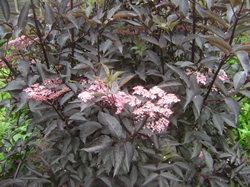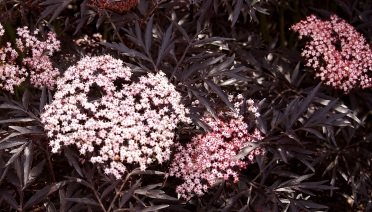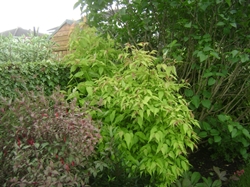
Sambucus ‘Black Lace’
Our native elder, Sambucus nigra can be a nuisance in the garden, particularly when it gets into an evergreen hedge. It can quickly make a large space for itself with its fast growing watery shoots, well able to shove aside the tighter hedging.And then when it drops its leaves in winter, it leaves a gaping hole. I’ve had to cut out volunteer elders from hedging and carefully paint the cut stumps with a weed killer concoction, as it was generally not possible to dig them out without damage being done.

Sambucus ‘Black Beauty’
Still, the elder is an important plant in the countryside, and looking lovely right now, with its flat flower heads, just as the similar looking cow parsley is starting to fade.
Who would ever think, that elder would be welcome in the garden, or for that matter the garden centre? But two new purple variants have come along which are really good garden plants. One is “Black Lace” and the other is “Black Beauty”. “Black Lace” is exactly that -black and lacy. It leans over slightly with the weight of its feathery foliage and with its contrasting pink (not white!) flowers, it has an exotic look.
“Black Beauty” has the regular elder leaves, its colour appears more intense to me, perhaps because the leaves are not dissected. I use “Black Beauty” as a spot plant, cutting it back in early spring. This improves the colour, and I was pleasantly surprised to find it still flowered well on the new wood.

These elders could be very useful in general landscaping, as they will thrive almost anywhere. As they are very dark, they are best used in small groupings, large plantings of them would be overpowering. “Black Lace” looks good as a large specimen, because of its lax habit, I’m not so sure the more rigid “Black Beauty” would work the same way.
They sell reasonably well in the garden centre – in as much as any deciduous shrub sells well. They present well in pots over a long period. A good selling point is that they are easier to grow then their nearest rival, the purple smoke bush, Cotinus “Royal Purple”.

And just a thought: elders can be very prone to black fly infestation, which is the ugliest of all the aphid tribe. The black fly would no longer be noticed against these dark plants.
On the go for much longer is the golden form of the non native elder, Sambucus racemosa. Not quite as cast iron as the other two but an easy enough plant to grow. The variety called “Sutherland Gold” which does not burn in sun (often a problem with pale plants) is one of the best golden foliage plants there is. It has a light ferny appearance which it holds all through the season. Its white flowers do not show up well enough against the yellow foliage, but no plant can have everything!

PS. The new Leycesteria formosa “Golden Lanterns” is shaping up to be just as good, if not better as a golden leaved shrub.
And there is a purple form of cow parsley, called “Raven’s Wing”, which is a reminiscent of Sambucus “Black Lace” and a very fine and beautiful plant it is, but alas, it is only short lived.
Source: HortiTrends News Desk




